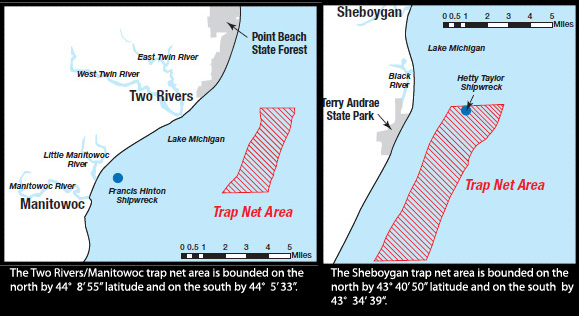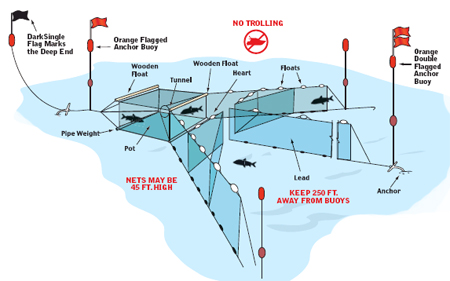Trap net safety on the Great Lakes
Fishing Wisconsin
TRAP NETS
Trap nets are large underwater nets used by commercial fishers to catch whitefish and let sportfish go. They pose a potential hazard for anglers and other boaters. Downriggers, fishing lines, and propellors can get caught in the nets or anchor ropes. Watch for the flags and buoys that mark these nets and give them a wide berth.
Safety
As a safety measure, boat operators trolling Lake Michigan and Lake Superior with downriggers are required to have wire cutters on board and have direct and immediate access to them. Should their boats get tangled up, operators can cut their downriggers or cables to free their boats from trap nets or other obstructions below the water's surface.
Nets are often marked with reflective tape. If you're fishing at night, carry a powerful flashlight to help see them.
Anglers fishing Lake Michigan south of Sheboygan harbor and between Manitowoc and Two Rivers should look for the nets in shallower water this year between June 29 and Labor Day. The nets are set between 60 feet and 150 deep in these limited areas on Lake Michigan, so anglers will know with certainty where the nets won't be so they can fish freely there.
Where to look for trap nets
Trap nets are used in parts of Lake Michigan and Lake Superior in late spring through fall. Commercial fishermen move the nets to follow the fish, so it's important to always be on the lookout for the flags and buoys that mark them. The nets are found in these general locations, however.
- Lake Michigan North of Sturgeon Bay and the Bay of Green Bay Commercial trap nets are numerous and moved around frequently. Look out for the flags and buoys and give them a wide berth.
- Sturgeon Bay to Sheboygan From June 29th through Labor Day, there are no commercial trap nets except in two small areas - one south of Sheboygan harbor and one between Manitowoc and Two Rivers harbors (see map below).
Under the existing rules, all parts of the trap nets must be in water deeper than 60 feet during this time. The maximum depth for trap nets remains 150 feet all year. This change in the minimum depth of nets will allow anglers to know for certain where the nets won't be so they can fish freely there.
Before and after those dates, trap nets may be found anywhere in that area - anglers should look out for the flags and buoys and give them a wide berth. - Lake Superior Trap nets are found most often between Houghton Point and Bayfield, but be on the lookout for their markers in other parts of the lake as well.
How to identify trap nets
- Trap nets are generally fished perpendicular to shoreline (from shallow to deep water). A double flag marks the lead or shoreward end, of the net and a single dark flag marks the pot, or lakeward end, of the net.
- Orange flags attached to a staff buoy at the pot must be at least four feet above the water surface. Flags will be about 18 by 9 inches. Be aware during rough water or heavy currents, these flags may tip down or be hidden by high waves.
- Orange buoys may also mark the ends of the wings.
- The staff of the nets is marked with reflective tape.
How to avoid trap nets
- Look for the flag markers and buoys marking the nets. At night, use a strong light to see the reflective tape on the flags.
- Give wide berth when passing trap net buoys and flag markers, as nets have many anchor lines extending in all directions.
- Do not pass or troll between trap net buoys as propeller blades or other fishing gear may easily snag net lines.
What to do if you get tangled in a net
- Cut any lines and cables immediately.
- Keep the bow of your boat heading into the waves
- Shut off your engines.
- Don’t get in the water to try to free lines or fishing gear.


